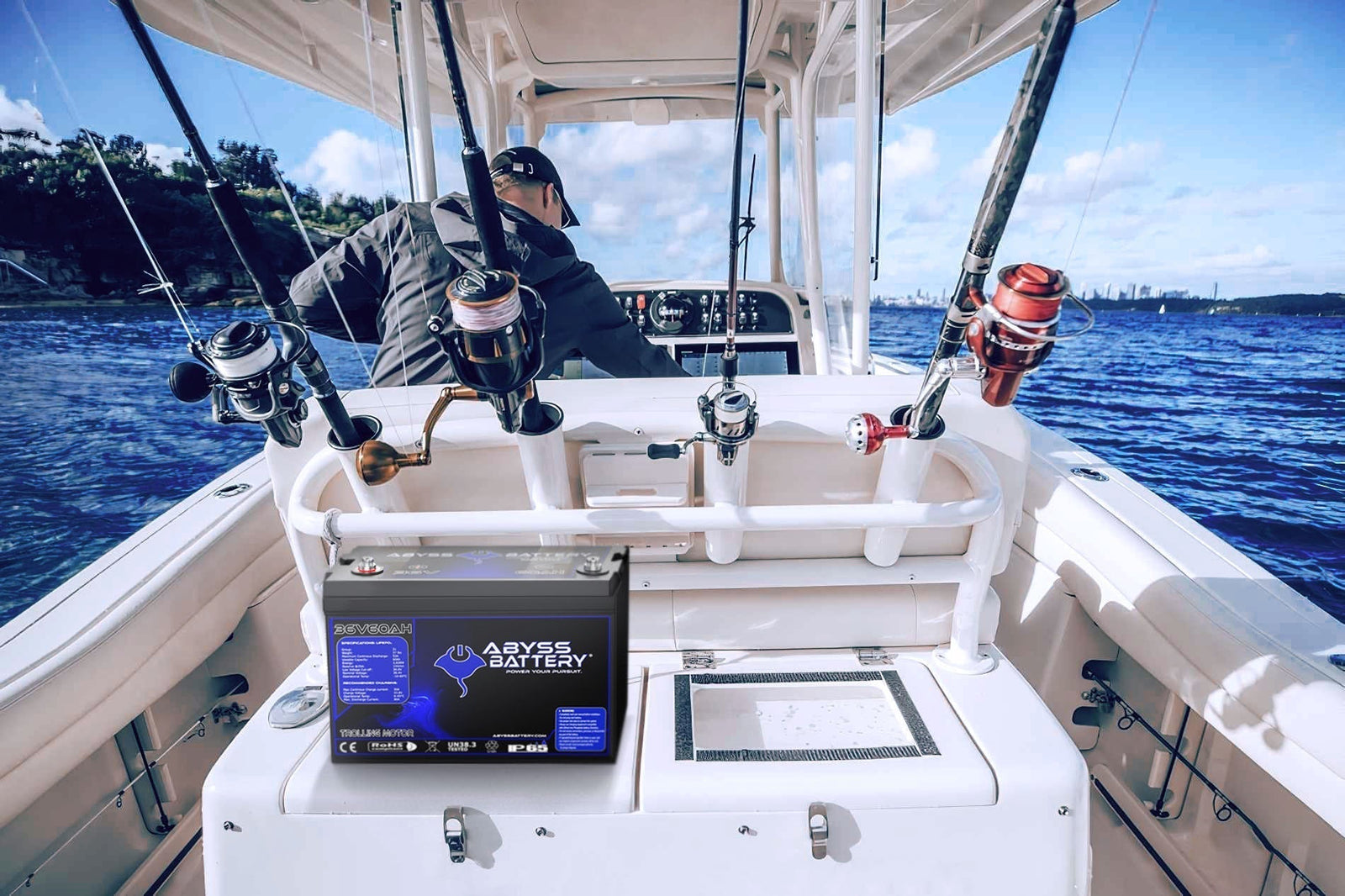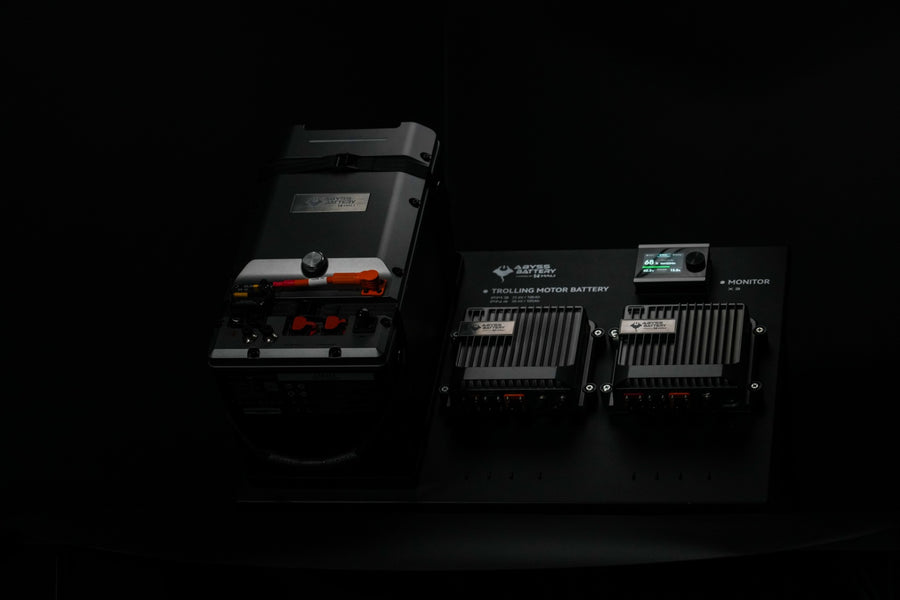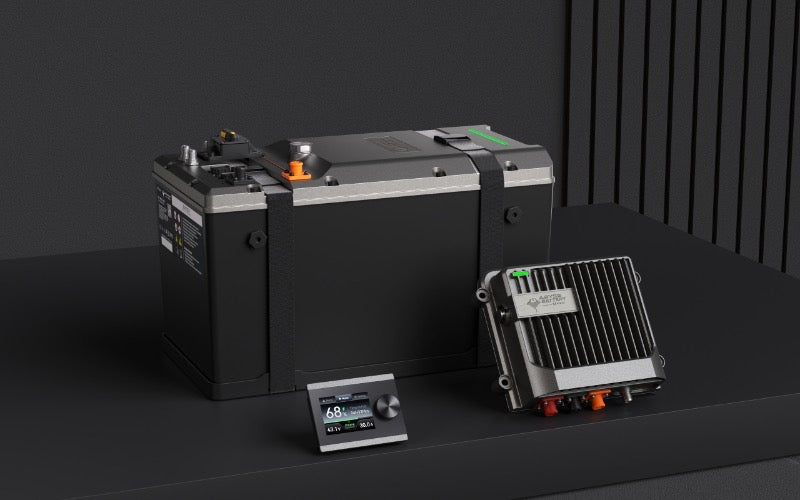NMEA 2000® Lithium Batteries That Talk to Your MFD: Meet Our 12V 220Ah & 24V 110Ah Dual‑Purpose Models

Your battery can finally speak fluent NMEA 2000®. That means live state‑of‑charge, volts, amps, temps, and alarms right on your chartplotter—no guessing, no extra gateways. We built two workhorses to power and protect serious boats:
-
12V 220Ah Dual‑Purpose LiFePO₄ — a deep‑cycle house/starting solution for modern 12V systems.
-
24V 110Ah Dual‑Purpose LiFePO₄ — serious cranking capability for starting large diesel motors while running high‑demand electronics.
If you’re upgrading electronics, adding a trolling motor, or you’re just done with slow, heavy lead‑acid, these are the batteries you were waiting for.
Why NMEA 2000® Batteries Matter
What it is: A battery with a native NMEA 2000 interface that publishes standard battery data right onto your boat’s existing NMEA 2000 backbone. Your MFD (Garmin, Simrad, Lowrance, Raymarine, Furuno, etc.) can display it—because standards are beautiful when they actually… standard.
What it’s not: A charger, a regulator, or magic. NMEA 2000 is a data bus. You still need proper charging gear and protection per ABYC E‑11 best practices. Good news—we play nice with modern lithium‑capable chargers, DC‑DC chargers, and alternator protection strategies.
The Lineup at a Glance
12V 220Ah Dual‑Purpose Lithium Marine Battery
-
Use cases: House bank for fishing electronics, livewells, pumps, radar, lights; can be used for starting where engine manufacturer requirements allow.
-
Highlights: Massive usable capacity, low internal resistance for crisp voltage under load, fast charging with compatible chargers, native NMEA 2000 visibility.

24V 110Ah Dual‑Purpose Lithium Marine Battery (Diesel‑Start Ready)
-
Use cases: 24V house/aux systems on sportfishers, cruisers, and commercial rigs; starting large diesel motors that demand high cranking performance.
-
Highlights: High cranking capability, rock‑solid voltage curve, deep‑cycle endurance between starts, NMEA 2000 monitoring baked in.
Straight talk: If your diesel OEM specifies a minimum cranking current or battery type, check it. Our 24V 110Ah is built for the job, but you should always match battery capability to engine requirements.
Real‑Time Battery Data on Your MFD
Our NMEA 2000 batteries publish standard battery parameters so you can actually run by numbers:
-
State of Charge (SOC)
-
Voltage & Current
-
Battery Temperature
-
Time‑to‑Empty / Time‑to‑Full (as supported by your display)
-
Warnings/Alarms (over/under‑voltage, temp, etc.)
Tech note for installers: We support standard NMEA 2000 battery PGNs (e.g., Battery Status and DC Detailed Status) so you see the expected data fields on popular MFDs that implement these PGNs. Exact screen layouts vary by brand.
Dual‑Purpose That Actually Earns the Name
“Dual‑purpose” gets abused in marketing. Here’s what it means here:
-
Starting: Low internal resistance = strong cranking performance (especially the 24V 110Ah for big diesels).
-
Deep‑Cycle: LiFePO₄ chemistry sustains high cycle counts with consistent voltage, so your sonar and MFDs stay happy even when you’re running hard.
Installation: Clean, Simple, Standard
-
Network: Add a standard NMEA 2000 tee to your backbone and run a short Micro‑C drop to the battery’s NMEA 2000 port. Ensure both ends of the backbone are properly terminated.
-
Power & Protection: Size main fuses/breakers and cables per ABYC and equipment load.
-
Charging: Use lithium‑compatible profiles on chargers. For high‑output alternators feeding lithium, plan for DC‑DC charging or lithium‑safe external regulation to protect the alternator.
-
Commissioning: Power the N2K network, confirm the battery shows up on the MFD, label the instance (e.g., “House 1” / “Start 24V”) and you’re off.
If you’re unsure, a qualified marine electrician is worth every penny of not letting the smoke out.
Specs Snapshot
Replace any “TBD” fields with your official numbers before publishing.
| Feature | 12V 220Ah Dual‑Purpose | 24V 110Ah Dual‑Purpose |
|---|---|---|
| Nominal Voltage | 12.8V (LiFePO₄) | 25.6V (LiFePO₄) |
| Capacity | 220Ah (≈2.8 kWh) | 110Ah (≈2.8 kWh) |
| NMEA 2000® | Native interface | Native interface |
| Use Case | House / Start (per engine reqs) | Start large diesels + house |
| Chemistry | Lithium Iron Phosphate | Lithium Iron Phosphate |
| Cycle Life | High (fill in tested cycles) | High (fill in tested cycles) |
| Flammability | UL94-VO | UL94-VO |
| Waterproof | IP67 | IP67 |
| Warranty | 5 Year Free Replacement | 5 Year Free Replacement |
Common System Pairings
-
Offshore center console (12V): 12V 220Ah house for MFDs/sonar/radar + outboard start. NMEA 2000 puts SOC and alarms on the helm so you stop “running by vibe.”
-
Sportfisher with 24V electronics/diesel: 24V 110Ah serves as the start bank for large diesels and a deep‑cycle source for 24V loads. Add DC‑DC charging from 12V if needed and monitor everything on the MFD.
-
Guides & pros: Faster charging between trips, repeatable voltage for sensitive electronics, and live battery telemetry that earns you uptime.
Charging & Alternators (Important)
Lithium makes alternators work harder because it accepts current aggressively at a low, stable voltage. If your alternator is stout (or you run twin/triple engines), use a DC‑DC charger or external regulator with lithium‑safe profiles to keep alternator temps in the green. This is one of those “do it right the first time” items.
What You’ll See on the Screen (Typical)
-
House Battery Page: SOC (%) with time remaining, voltage, net amps in/out, temp.
-
Start Battery Page (24V diesel): Voltage, temp, alarms—useful for pre‑start checks and diagnosing parasitic loads.
-
Alarms: Under‑voltage, over‑voltage, high temp, etc., routed through the MFD so the helm gets the heads‑up.
Honest Pros & Cons
Pros
-
Live battery intelligence on your MFD (no extra gateways).
-
True dual‑purpose performance (start + deep‑cycle).
-
Faster charging and stable voltage for modern electronics.
-
Lighter weight vs. equivalent lead‑acid capacity.
Considerations
-
Requires lithium‑compatible charging gear.
-
Alternators may need DC‑DC or external regulation for heavy duty cycles.
-
Cold‑weather charging must follow LiFePO₄ temperature limits.
FAQs
Will it work with my Garmin/Simrad/Lowrance/Raymarine/Furuno?
Yes—our batteries communicate over standard NMEA 2000 PGNs. If your display supports those PGNs (most do), you’ll see the data. Screen layouts vary by brand.
Do I still need a battery monitor?
Most owners won’t. Your MFD becomes the monitor. If you want redundancy or mobile access, you can add a dedicated monitor or an app gateway as a secondary tool.
Can the 24V 110Ah really start big diesels?
Yes. It’s designed as a dual‑purpose 24V battery with high cranking capability. Always match to the engine manufacturer’s minimum requirements for cranking current and battery type.
Can I mix lithium with my existing lead‑acid bank?
Don’t directly parallel unlike chemistries. Use DC‑DC chargers to bridge systems cleanly if you need to share charging.
Do I need special cables or tees for NMEA 2000?
Use standard NMEA 2000 Micro‑C tees, drops, and proper termination. Keep total backbone length and power injection per NMEA guidelines.




Leave a comment